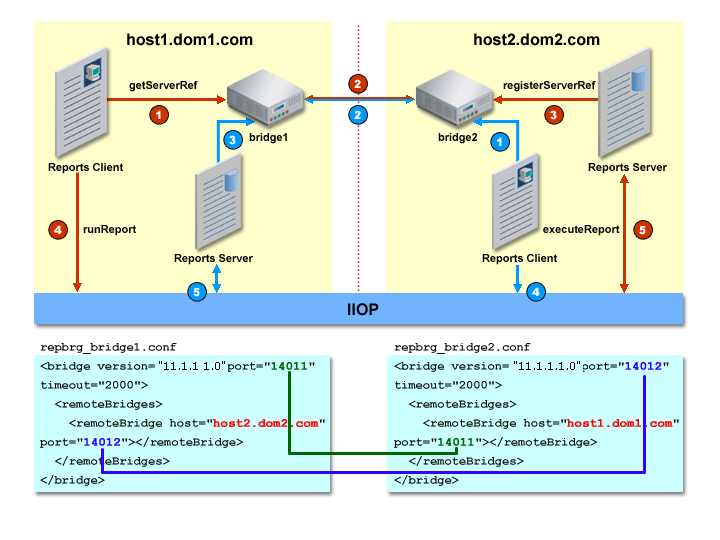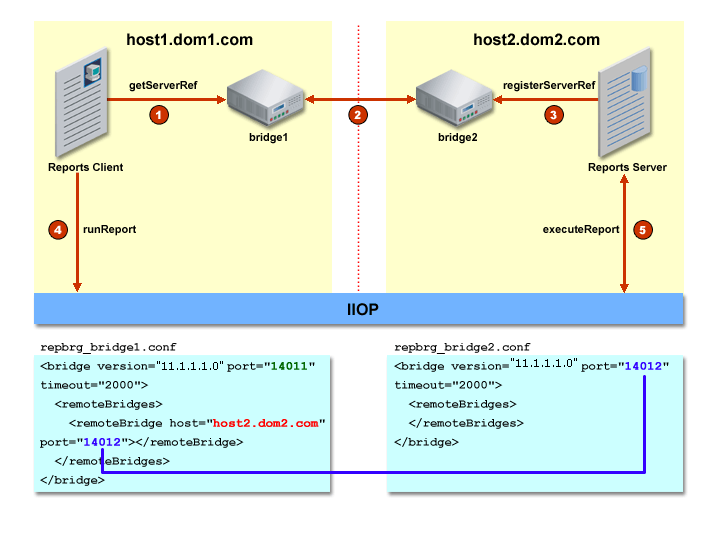7.4 Oracle Reports Bridge Configuration File
The Oracle Reports Bridge configuration settings for the Reports Server component of Oracle Reports Services are stored in the XML file rwbridge.conf.
The bridgeconfig.xsd file contains data type definitions for rwbridge.conf elements and attributes. See Section 7.4.1, "Oracle Reports Bridge Configuration Elements".
These files are located in the directories specified in Table 7-1.
7.4.1 Oracle Reports Bridge Configuration Elements
The bridgeconfig.xsd contains the data type definitions for the various Oracle Reports Bridge configuration file (rwbridge.conf) elements and attributes.
The Oracle Reports Bridge acts as a gateway for packets that are broadcast by Reports Server and Reports Client across Farms. For example, in a sample setup, Oracle Reports components are installed on different Farms: Oracle Reports Servlet is in Farm A and Reports Server is in Farm B. To achieve this configuration, the Oracle Reports Bridge has to be started on each Farm. Bridge configuration will include the host and port settings. The Oracle Reports Bridge in Farm A will contact the Oracle Reports Bridge in Farm B through reliable TCP to retrieve the server information on Farm B, and vice versa. For more information, see Section 2.3.4.1.2, "Server Discovery Across Subnets".
To start and stop the Oracle Reports Bridge, refer to Chapter 5, "Starting and Stopping Oracle Reports Services".
Oracle Reports creates the configuration file rwbridge.conf when the Oracle Reports Bridge is started for the first time. This file is generated based on the settings in the rwbridge.template file.
In the configuration file, rwbridge.conf, modify the identifier element to specify the username/password and set the encrypted attribute to no. This indicates that the password is not encrypted. This password will be encrypted once the Oracle Reports Bridge is started.
For example:
<identifier encrypted="no">scott/tiger</identifier>
-
If the
identifierelement is commented, then it is possible to stop the Oracle Reports Bridge without specifyingauthid. -
It is not possible to stop the Oracle Reports Bridge remotely.
See Also:
Section 7.4.1.2, "identifier"The bridgeconf.xsd file provides the following data type definitions for configuring rwbridge.conf elements and attributes:
Note:
The configuration elements described in this section can be configured in Oracle Enterprise Manager:-
Select Reports > Administration > Bridge Configuration to display the Reports Bridge Component Configuration page.
7.4.1.1 bridge
The bridge element is defined in bridgeconfig.xsd as follows:
<xs:element name="bridge">
<xs:complexType>
<xs:sequence>
<xs:element ref="identifier" minOccurs="0" maxOccurs="1"/>
<xs:element ref="remoteBridges" minOccurs="0" maxOccurs="1"/>
</xs:sequence>
<xs:attribute name="version" use="required" type="xs:string"/>
<xs:attribute name="port" default="14011">
<xs:simpleType>
<xs:restriction base="xs:integer">
<xs:minInclusive value="14001"/>
</xs:restriction>
</xs:simpleType>
</xs:attribute>
<xs:attribute name="timeout" use="required">
<xs:simpleType>
<xs:restriction base="xs:integer">
<xs:minInclusive value="100"/>
</xs:restriction>
</xs:simpleType>
</xs:attribute>
</xs:complexType>
</xs:element>
<bridge version="11.1.1.1.0" port="14011" timeout="12000">
<!--networkConfig file="rwnetwork.conf" ></networkConfig-->
<!--identifier encrypted="no"
>%USERNAME%/%PASSWORD%</identifier-->
<!--trace traceOpts="trace_all"></trace-->
<!-- Specify one or more remote bridges inside remoteBridges element -->
<!--remoteBridges>
<remoteBridge host="%HOST%" port="%PORT%"></remoteBridge>
</remoteBridges-->
</bridge>
Required. You can have a maximum of one open tag and one close tag in the bridge element in a given configuration file.
The bridge element opens and closes the content area of the bridge configuration file. In terms of the file's hierarchy, all the other elements are subordinate to the bridge element.
The bridge element attributes are described in Table 7-29.
Table 7-29 Attributes of the bridge Element
| Attributes | Valid Values | Description |
|---|---|---|
|
|
The bridge version. |
|
|
The allotted range for Oracle Reports Bridge component; that is, |
The port on which the bridge will listen. |
|
|
|
Value in milliseconds (ms). The bridge will wait for this period for a response from a remote bridge. |
Note:
The default port value for the bridge configuration file is assigned when you install Oracle Fusion Middleware. Therwbridge.template file contains this default port, which is used to generate the configuration file for the bridge. The configuration file name for a bridge is ORACLE_INSTANCE/config/ReportsBridgeComponent/<bridge name>/rwbridge.conf.
If you need to customize the port number for the bridge, you must specify a valid port range reserved for the Oracle Reports Bridge bridge (14011 to 14020).
7.4.1.2 identifier
The identifier element is defined in bridgeconfig.xsd as follows:
<xs:element name="identifier">
<xs:complexType mixed="true">
<xs:attribute name="encrypted" default="no">
<xs:simpleType>
<xs:restriction base="xs:NMTOKEN">
<xs:enumeration value="yes"/>
<xs:enumeration value="no"/>
</xs:restriction>
</xs:simpleType>
</xs:attribute>
</xs:complexType>
</xs:element>
<identifier encrypted="yes">fpoiVNFvnlkjRPortn+sneU88=NnN</identifier>
Optional. If this element is commented, then the Oracle Reports Bridge will not perform a security check when the bridge shutdown command is issued.
The identifier element ensures that the Oracle Reports Bridge performs a security check before shutting down.
To set the value of the identifier element:
-
Uncomment the
identifierelement in the bridge configuration file. -
Set the value to the administrator username/password, set the attribute
encrypted=no, so that the username/password will be encrypted when the Oracle Reports Bridge is restarted.For example:
<identifier encrypted="no">scott/tiger</identifier>
-
Start the Oracle Reports Bridge.
Once this element is set, only the administrator will be able to shut down the bridge by specifying the username/password in the command line.
7.4.1.3 remoteBridge
The remoteBridge element is defined in bridgeconfig.xsd as follows:
<xs:element name="remoteBridge">
<xs:complexType>
<xs:attribute name="host" use="required" type="xs:string"/
<xs:attribute name="port" use="required">
<xs:simpleType>
<xs:restriction base="xs:integer">
<xs:minInclusive value="14001"/>
</xs:restriction>
</xs:simpleType>
</xs:attribute>
</xs:complexType>
</xs:element>
<remoteBridge host="myhost.mydomain.com" port="14022"></remoteBridge>
Optional. You can have one or more remoteBridge elements in your bridge configuration file.
The remoteBridge element specifies the host and port on which remote bridges are running.
Figure 7-1 Oracle Reports Bridge Configuration (Two-Way)

Description of "Figure 7-1 Oracle Reports Bridge Configuration (Two-Way)"
If you specify the optional remoteBridge element(s) in the repbrg_bridgename.conf, then the bridge will act as a two-way bridge. That is, the bridge can get server references from remote bridges.
Figure 7-2 Oracle Reports Bridge Configuration (One-Way)

Description of "Figure 7-2 Oracle Reports Bridge Configuration (One-Way)"
If you do not specify the optional remoteBridge element(s) in the repbrg_bridgename.conf, then the bridge will act as a one-way bridge. That is, the bridge can only serve remote bridges. It cannot connect to remote bridges to get the server reference.
The remoteBridge element attributes are described in Table 7-30.
7.4.1.4 remoteBridges
The remoteBridges element is defined in bridgeconfig.xsd as follows:
<xs:element name="remoteBridges">
<xs:complexType>
<xs:sequence>
<xs:element ref="remoteBridge" minOccurs="0" maxOccurs="unbounded"/>
</xs:sequence>
</xs:complexType>
</xs:element>
<remoteBridges> <remoteBridge host="myhost.mydomain.com" port="14022"></remoteBridge> </remoteBridges>
Optional. If this entry is not specified, then this bridge will not contact any remote bridge to get a Reports Server reference. However, remote bridges can contact this bridge to get the references of Reports Servers running in this farm.
The remoteBridges element can contain zero or more remoteBridge elements.